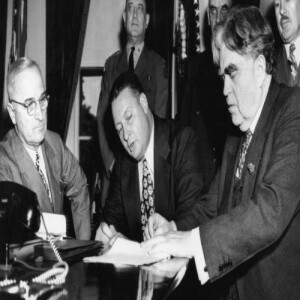
On this day in labor history, the year was 1946.
That was the day 400,000 bituminous coal miners walked off the job in 26 states.
They demanded higher wages, better health benefits and safety regulations.
The strike began to cripple industrial operations nationwide.
By May 22, President Truman seized the mines. Miners returned to work a week later.
John L. Lewis, president of the United Mine Workers, signed an agreement with Secretary of the Interior, Julius Krug.
It included $wage increases and vacation pay, the five day workweek and contributions to a retirement fund.
The strike led to “The Promise of 1946,” otherwise known as the Krug-Lewis Agreement.
It created the UMWA Health and Retirement Funds.
It is this fund that is often referred to in present day discussion concerning the loss of retiree health and pension benefits.
According to Robert Hartley and David Kenney, authors of Death Underground: The Centralia and West Frankfort Mine Disasters, “the welfare program was to provide medical care, rehabilitation treatment and death benefits.
It provided the authority for the Director of the U.S. Bureau of Mines to establish a Federal Mine Safety Code… to enforce mine safety regulations and provided the first legal authority for federal inspectors to close mines found to be dangerous.”
Lack of enforcement would prove deadly for miners in Centralia and West Frankfort. The Health and Welfare Funds, however, provided relief and security for miners for decades.
But in recent years, many companies have gone out of business and found legal loopholes to shed their retirement responsibilities.
Those miners affected are today fighting for the passage of the Miners Protection Act, which would provide access and funding to shore up the pension plan.
More Episodes
 2024-09-30
2024-09-30
 2024-09-28
2024-09-28
 2024-09-28
2024-09-28
 2024-09-28
2024-09-28
 2024-09-22
2024-09-22
 2024-09-21
2024-09-21
 2024-09-20
2024-09-20
 2024-09-19
2024-09-19
 2024-09-18
2024-09-18
 2024-09-17
2024-09-17
 2024-09-16
2024-09-16
Create your
podcast in
minutes
- Full-featured podcast site
- Unlimited storage and bandwidth
- Comprehensive podcast stats
- Distribute to Apple Podcasts, Spotify, and more
- Make money with your podcast
It is Free
- Privacy Policy
- Cookie Policy
- Terms of Use
- Consent Preferences
- Copyright © 2015-2024 Podbean.com




